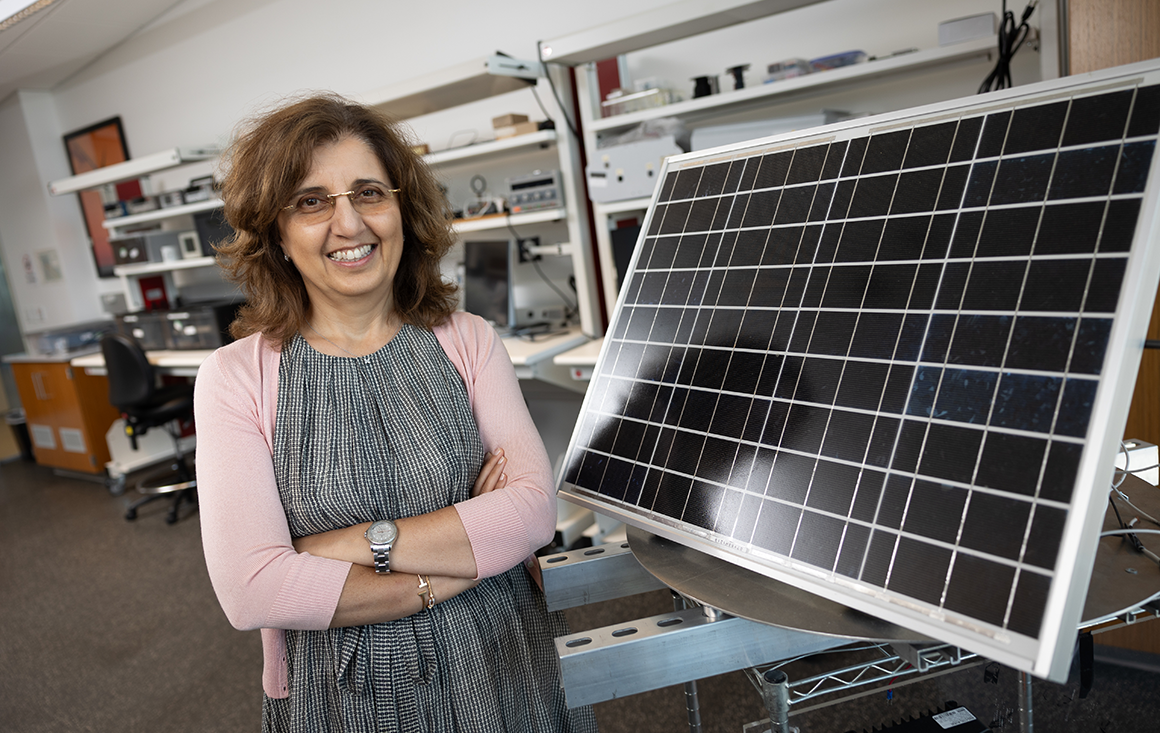
The Right Idea at the Right Time
These days, when we flip a switch, we don’t think too deeply about how far electricity has to travel to turn on our lights.
In fact, electricity often runs hundreds of miles from power plants, through transformers, and across transmission lines, just to get to our cities. While this vast system works most of the time, it’s far from infallible. If flooding or heavy winds down power lines or short a transformer in some distant part of the grid, thousands of people miles away could easily be stuck in the dark.
And now, due to climate change, the outages we’ve seen from blizzards in Texas or fires in Northern California are just the tip of the iceberg, says associate professor Maryam Khanbaghi.
Not only is our grid vulnerable to these more frequent extreme weather events—the grid itself is antiquated. Seventy percent of power lines and transformers are more than 25 years old. That means as we introduce newer technologies like solar and wind power, the outdated system struggles to keep up.
“I often ask my students, why are we spending so much money to remake the grid exactly as it was designed by Nikola Tesla and Thomas Edison 100 years ago?” she says. “If we want to go fully renewable, we need to reimagine how we want the grid to look 20 years from now.”
There’s also a critical environmental justice issue at play. Power grid failures occur more in lower-income communities where grids can be in greater disrepair. Since these communities are less likely to have backup power, they are often without internet, water, air conditioning, heat, and cooked food for days.
Short-term repairs aren’t enough, Khanbaghi says. That’s why she’s dedicated her research to uncovering new paths in microgrids, control theory, and machine learning to overcome the challenges our grids face.

Illustration by Tu Tran
The grid of tomorrow
For Khanbaghi, our grid’s most significant vulnerability is its sprawling size—but this big problem might be solved by thinking smaller.
“What if everything could be built around a substation? Instead of sending electricity hundreds of miles, if we kept transmission localized around secondary substations, we could minimize the impact of disruptions. This is where microgrids come into play.”
Microgrids aren’t a new idea, but thanks to new technology, they could now offer the flexibility and independence needed for a more robust grid. This is especially important when accounting for the increasing use of solar and wind power, which aren’t always predictable or sufficient to meet demand.
Take Santa Clara University and nearby Mineta Airport. The “load”—or energy consumption—is very specific and predictable. Students go home for summer and winter breaks. More passengers fly during the holidays, but there are fewer flights in the night.
“There are no surprises,” Khanbaghi explains. “You can collect the data and see when an area needs or doesn’t need electricity. The question is how to mix and match supply and demand.”
Khanbaghi envisions a system of multiple microgrids, each compensating for factors like varying load, fluctuating renewable supply, and weather disruptions. When a microgrid has surplus electricity, it could lend it to nearby microgrids when needed—a process that could be automated once engineers are able to design the proper control algorithm.
It’s an idea that recently helped Khanbaghi win a prestigious National Science Foundation CAREER Award which will fund the next five years of her and her students’ research at the Latimer Energy Lab, where students will explore photovoltaic design, energy efficiency, and more.
“In my [NSF Award] proposal, I highlighted the many people using all the data and technology available to us through artificial intelligence, machine learning, and deep learning. But it’s important not to neglect control theory. I believe that by combining control theory and this new technology, we can make a difference.”

Khanbaghi stands in front of a microgrid simulator.
Opening windows
Two years after Congress passed the Infrastructure Bill, more and more Americans are understanding the need to invest in clean water, fast internet, new roads and bridges, and sustainable transportation.
With these infrastructure overhauls top of mind, Khanbaghi says her research is part of this national conversation—and she’s already seeing meaningful contributions from her students working in the Latimer Lab. For example, this year, a group of students—Terrin Cramer ’23,Yicheng Kang ’23, Ryan Ogino ’23—did their senior design project on reducing heat inefficiency in solar panels by mimicking the water circulation found within the cold-loving ghost plant.

At the Latimer Lab, students can measure the solar power generation and use at Santa Clara University.
It’s the kind of innovative thinking that thrives at the Latimer Lab where Khanbaghi has just one rule: think big—bigger voltage, to be exact. The lab boasts a range of state-of-the-art equipment, including a full microgrid simulator, and Khanbaghi encourages her students to challenge themselves in the space.
And they’re not the only ones finding inspiration in the Latimer Lab. The NSF Award has opened a window onto her work, inspiring new interest from Khanbaghi’s peers in the School of Engineering.
“It’s so important to have that collaboration because this issue touches computer engineering, computer science, mechanical and material science, even civil engineering. I love seeing all these departments get excited about power and energy—the Latimer Lab is for everyone.”
One potential overlap that Khanbaghi is eager to explore is cybersecurity. With such an old system, security protocols in grid computers aren’t up to par with the cyberattacks we see today. “If an enemy takes over the grid, then we are done,” she explains.
To her, it will take the best minds from across disciplines to reinvent the wheel, so to speak, but given how dependent we are on electricity, it’s a matter of profound urgency.
“Electricity is the best invention of the 20th century, but it’s down to us in the 21st century to keep it up.”